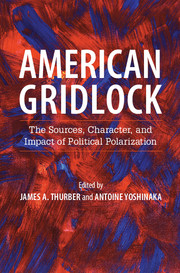Book contents
- Frontmatter
- Dedication
- Contents
- List of contributors
- Foreword
- Acknowledgments
- Introduction
- PART I POLARIZATION AMONG VOTERS AND ACTIVISTS
- PART II POLARIZATION IN NATIONAL INSTITUTIONS
- 6 Presidential-Congressional Relations in an Era of Polarized Parties and a 60-Vote Senate
- 7 Party Warriors: The Ugly Side of Party Polarization in Congress
- 8 The Sources and Consequences of Polarization in the U.S. Supreme Court
- PART III POLARIZATION IN THE STATES
- PART IV POLARIZATION IN THE MEDIA
- PART V IMPLICATIONS AND CONCLUSIONS
- Index
- References
8 - The Sources and Consequences of Polarization in the U.S. Supreme Court
from PART II - POLARIZATION IN NATIONAL INSTITUTIONS
Published online by Cambridge University Press: 05 November 2015
- Frontmatter
- Dedication
- Contents
- List of contributors
- Foreword
- Acknowledgments
- Introduction
- PART I POLARIZATION AMONG VOTERS AND ACTIVISTS
- PART II POLARIZATION IN NATIONAL INSTITUTIONS
- 6 Presidential-Congressional Relations in an Era of Polarized Parties and a 60-Vote Senate
- 7 Party Warriors: The Ugly Side of Party Polarization in Congress
- 8 The Sources and Consequences of Polarization in the U.S. Supreme Court
- PART III POLARIZATION IN THE STATES
- PART IV POLARIZATION IN THE MEDIA
- PART V IMPLICATIONS AND CONCLUSIONS
- Index
- References
Summary
This chapter examines polarization in the U.S. Supreme Court, primarily from the post–New Deal era to the present. I describe and document how the ideological center on the Court has gradually shrunk over time, though importantly, it has not disappeared altogether. I provide an examination and discussion of both the sources and consequences of these trends. Key insights and findings include:
• Polarization in the Supreme Court has generally increased over time, though this trend has ebbed and flowed. The most robust center existed during the Burger Court of the mid-to-late 1970s, consisting of arguably five swing justices.
• Although the center has shrunk over time on the Court, it still exists due to (1) presidents from Truman to George H. W. Bush not placing exclusive emphasis on ideological compatibility and reliability when appointing justices, (2) an increase in the incidence of divided government, and (3) the rarity of strategic retirements by the justices. Since President Clinton took office, the norms have shifted more firmly to strategic retirements by the justices and presidents placing near exclusive emphasis on ideological compatibility and reliability in the appointment process.
• The existence of swing justices on the Court – even having just one swing justice – has kept Supreme Court outputs relatively moderate and stable despite Republican domination of appointments from Nixon to George H. W. Bush. The elimination of swing justices would likely lead to more volatile policy outputs that fluctuate based on membership changes.
• A “polarization paradox” exists: The incidence of 5-4 case outcomes has increased over time, but the incidence of unanimous outcomes has increased as well. Polarization on the Court may be dependent on whether the Court is deciding cases within its “volitional agenda” (politically salient issues) or “exigent agenda” (institutional maintenance).
• A vicious circle exists between polarization on the Court and Supreme Court appointments. With just one swing justice (Kennedy) on the current Court, whoever is president (Obama and beyond) has the chance to create the first ideologically homogeneous majority voting bloc since the Warren Court of the 1960s. Constraints on this ability rest on divided party control of the Senate, the use of the filibuster by the minority party, and the majoritye's possibly using the “nuclear option” to eliminate the filibuster for Supreme Court nominations.
- Type
- Chapter
- Information
- American GridlockThe Sources, Character, and Impact of Political Polarization, pp. 171 - 200Publisher: Cambridge University PressPrint publication year: 2015
References
- 6
- Cited by



